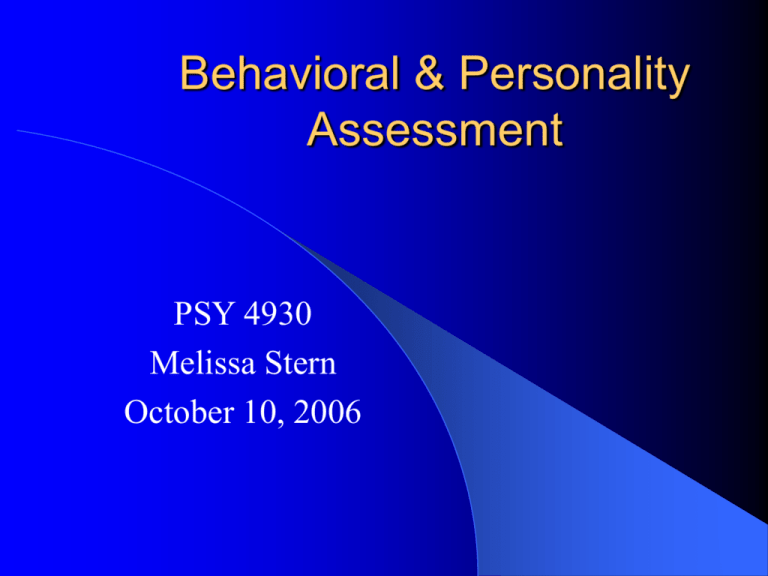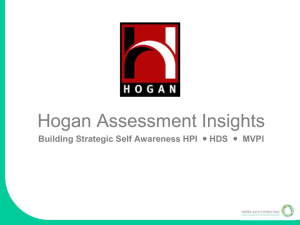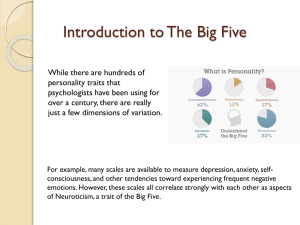Behavioral & Personality Assessment
advertisement

Behavioral & Personality Assessment PSY 4930 Melissa Stern October 10, 2006 Outline for Today Go over Exam Lecture Fact Finding Mission Exam Exam Questions we “threw out” – 26 – 40 – 43 This means we added 6 points to EVERYONE’S total score Exams Before we gave you 6 pts 22 exams > 90 13 exams 80 - 89 11 exams 70 – 79 5 exams 50 - 69 After we gave you 6 pts 30 exams > 90 15 exams 80-89 3 exams 70-79 3 exams 60-69 Exam Review of the questions and answers Behavior Assessment • Observational assessment • Narrative recording • Interval recording—observations are divided into time segments, target behaviors are recorded • Observational coding systems (DPICS) • Event recording • Ratings recording • Self-Monitoring record Self-Monitoring Record Situation What happened before? Kids were The bell laughing rang when I gave my presentation What happened after? Thoughts Feelings My face turned red, I messed up my presentation They’re Sad making Embarasfun of me, sed Nobody likes me, I’m stupid Subjective Unit of Distress (1-10) 8 Observational Assessment Advantages Disadvantages – Can quantify target – Time intensive behaviors – Can clarify parent- and teacher-report data – May provide qualitative data as well – Trained observers with reliability checks – May require intensive training – Reactivity effects – May not generalize/be representative – May miss other behaviors of interest Behavior Assessment: Rating Scales Epidemiology and classification Screening Assessment Intervention planning Outcome- treatment effectiveness **Warning- use with extreme caution with making diagnoses How accurate are rating scales? 1) Rating scales with more global items are more susceptible to biased information. 2) Generally, the more response choices, the better (although there's a limit) 3) Specificity of anchors/answer choices provides more precision of response 4) Time period affects responding (i.e. how long ago that behavior occurred, or how long a period of time they are supposed to recall to assess behaviors) Why do we use parents and teachers? 1) They often make the referral 2) They provide information about the child in variety of situations and for a variety of behaviors 3) They often have a longitudinal familiarity with the child 4) Parents- compare to other siblings knowing how household functions 5) Teachers- can compare child to other students (more aware of developmental norms) How convergent are parents and teachers (and children)? 1) Between parent agreement generally modest – Lower between parents for personality assessment (internalizing issues) rather than behavioral problems 2) Agreement much lower for individual items than overall scores 3) Generally, parent scores tend to be higher than teacher scores, with modest agreement overall 4) Generally, parent scores of externalizing problems tend to be higher than child report 5) Generally, parent scores of internalizing problems tend to be lower than child report Personality Inventory for Children (PIC) Measures a wide range of child functioning: behavior, affect, cognitive status Two versions: Long (420 questions) and Short (280 questions). Short is most frequently used. True False Format Takes approx 30 minutes Ages 3-16 Personality Inventory for Children (PIC) Developed from theoretical constructs, then validated using populations with specific maladaptive functioning. Also based on empirical research, primary factors of personality based on behavioral observations, and areas of interest believe to be useful for practicing clinicians. Subscales and Profile Types – Combinations of scale elevations to produce 12 profile types PIC Factors Based on scores from the subscales Factor I: Externalizing and acting out Factor II: Intellectual functioning Factor III: Internalization and psychological discomfort Factor IV: Activity Level Factor V: Somatic Concerns PIC Scales Lie- defensive response set Frequency- deliberate or unintentional exaggeration of symptoms or random responding Defensiveness Adjustment- poor psychological adjustment Achievement- academic achievement Intellectual Screening- impaired intellectual functioning or cognitive deficits Development- poor intellectual and physical development, developmentally delayed Somatic Concerns- health-related variables, PIC Scales Depression Family Relations- family effectiveness and cohesiveness Delinquency- behaviors matching those of juvenile delinquents Withdrawal- isolation from social contact, distrust of others, avoidance of people Anxiety- exaggerated concerns and worries, irrational fears Psychosis- thought disturbance Hyperactivity Social Skills- social relationships PIC: Strengths 1) 2) 3) 4) Large normative sample Sound psychometrics Very comprehensive Questions based on clinical profiles PIC: Weaknesses 1) Most norms collected in 1960’s and from Minneapolis Public School System 2) Norms primarily based on maternal report. Some criticize PIC saying its targeted too much toward mothers. 3) Questions based on clinical profiles Child Behavior Checklist (CBCL) Developed by Achenbach Two forms (ages 2-3 & ages 4-18) Approximately 20 min to complete 2-3 year old form: Subscales = Aggressive, Depressed, Destructive, Sleep Problems, Social Withdrawn, Somatic Problems Child Behavior Checklist 4-18 year old version: Total score, Externalizing (Aggressive, Delinquent), Internalizing (Anxious/Depressed, Somatic Complaints, Withdrawn), Social Competence (Activities, Social, School). Competence scores (low T is considered clinical) – Activity: number of activities child is involved in, the frequency of participation, and skill level in these – Social: depth and types of social interactions – School: grades, repetition of grade levels, special classes, and other school problems Teacher Report Form (TRF) Some items adapted to make them more appropriate for teachers. – Social competency items replaced with academic performance and adaptive functioning questions. Total, Externalizing (Aggressive, Delinquent), Internalizing (Anxious/Depressed, Somatic Complaints, Withdrawn), Adaptive Functioning (Behaving Appropriately, Happy, Learning, School Performance, Working Hard) Achenbach Measures: Strengths 1) Provides a more extensive assessment of social competency than many other rating scales 2) Supported by extensive empirical analyses as accurate measure of problematic child functioning 3) Accurately discriminates clinic referred vs. non-referred children 4) Good norms: normative samples were large and diverse. Scoring norms separate for ages (2-3, 4-5, 6-11, 12-18) and sex 5) Strong psychometric properties Achenbach Measures: Strengths 6) Having equivalent forms allows for information from multiple informants on similar questions and constructs, and allows for a detailed comaprison across informants and situations. 7) Can be used for a variety of purposesscreening, classification, treatment evaluation. 8) Provides competencies (strengths) not just weaknesses and problems 9) Empirically derived scales Achenbach Measures: Weaknesses 1) Limited range of response choices. 2) Questions are global; lack specificity 3) Measure as a whole is too broad Conners Rating Scales Focuses on ADHD symptoms, with additional measures of externalizing and internalizing problems Ages 3-17 Parent & Teachers version Long and Short version of each Responses on a 4 point scale (not at all, just a little, pretty much, very much) Conners Parent Rating Scale Long version (CPRS-R:L) Long version– 80 items (30 minutes to complete) – 14 factors: oppositional, cognitive problems, hyperactivity, anxious-shy, perfectionism, social problems, psychosomatic, Global Index (RestlessImpulsive, Emotional Lability), ADHD Index, DSMIV Symptoms subscale (DSM-IV Inattentive, DSM-IV Hyperactive-Impulsive) There is also a short version . . . Conners Teacher Rating Scale Long version (CTRS-R:L) Long version– 59 items (15 minutes) – 13 factors- oppositional, cognitive problems, hyperactivity, anxious-shy, perfectionism, social problems, Global Index (Restless-Impulsive, Emotional Lability), ADHD Index, DSM-IV Symptoms subscale (DSM-IV Inattentive, DSM-IV Hyperactive-Impulsive) There is also a short version . . . Conners Scale Descriptions Oppositional: break rules, problems with authority figures, easily angered Cognitive Problems: learn more slowly, organizational problems, completing tasks Hyperactivity: difficulty sitting still, restless Anxious-shy: excessive worries and fears, emotional, sensitive to criticism Perfectionism: set high goals, fastidious, obsessive about work Social Problems: have few friends, low self-esteem, distant from peers Psychosomatic: excessive physical symptoms ADHD Index: identifies children “at risk: for ADHD diagnosis. Global Index: items most sensitive to treatment effects, i.e. key ADHD symptoms DSM-IV Symptoms subscale: based on DSM-IV diagnostic criteria Conners Rating Scales: Strengths Huge normative sample Reliability between parents: moderate to high Reliability between teachers: moderate to high Reliability between parent and teacher: low adequate, w/ parents indicating more deviancy Validity: Discriminates between hyperactive/nonhyperactive, depressed/nondepressed, distinguishes between diagnostic groups. Conners Rating Scales: Weaknesses 1) All questions are worded negatively 2) Psychometric properties good, not great 3) Some factors have few questions 4) Test-retest reliability for younger children is unstable (developmental issue?) 5) Heavy loading of items on one factor (hyperactivity), while some have few items Eyberg Child Behavior Inventory (ECBI) Sutter-Eyberg Student Behavior Inventory-Revised (SESBI-R) Specifically assesses conduct problem behavior Ages 2-16 36/38 items: Questions selected from psychology clinic case records- thought to be most typical disruptive behaviors of children, and also very specific in nature Two scales– Intensity- frequency of occurrence (7 point Likert scale) – Problem- informant tolerance(yes/no) Takes only 5 to 10 minutes to complete ECBI & SESBI-R SESBI- 11 items identical to ECBI, 12 items slightly reworded, 13 new items – Reworded: “Teases or provokes other children/students” – Different items: Parent- “Dawdles in getting dressed” Teacher- “Has difficulty entering groups” Good screener Discriminates conduct problem children from those without problematic behavior. Accuracy of classification: 91%. Sensitive to treatment ECBI & SESBI-R: Strengths 1) Good normative sample 2) Strong psychometrics 3) Strong classification rates for conduct problems and normal behavior 4) Suitable across a wide range of populations 5) Strong correlations from parent to parent, teacher to teacher, and both are stable over time ECBI & SESBI-R: Weaknesses 1) Mother scores tend to be higher than father scores (true for most rating scales) on ECBI 2) SESBI scores for high SES preschoolers likely to be lower 3) Correlations between ECBI and SESBI scores not significant (should they be?) 4) Factor Structure Inconsistent A note about measures . . . Objective: contain clear and structured items, limited response sets, scoring is precise and straightforward – CBCL – ECBI/SESBI – CPRS/CTRS • Projective: contain ambiguous stimuli, covert personality traits are “projected” onto the stimuli, responses are interpreted based on criteria Personality Assessment Minnesota Multiphasic Personality Inventory – Adolescent (MMPI-A) MMPI-A The MMPI-A is often referred to as an objective personality test; however, it was actually designed to assess psychopathology rather than personality – Scale development based on differential responses to items by the specific criterion groups and normal groups – e.g., If most depressed teenagers in the normative sample answered a question a particular way, when a patient taking the test answers that way for a question, it contributes to a score on a scale of depression MMPI-A It was published in 1992 It is comprised of 478 true/false items Age range = 14-18 years Standardization sample was 1,610 adolescents who lived in eight different states California, Minnesota, New York, North Carolina, Ohio, Pennsylvania, Virginia, and Washington Updating the MMPI The original MMPI had over 10,000 publications, so although the inventory was updated, there were also efforts to not change too much of it so that the literature would not be lost The language and norms were updated in the MMPI-2 and MMPI-A (e.g., a question about playing drop the handkerchief was deleted) Updating the MMPI The MMPI-A uses uniform T scores – This ensures that the same T score elevation has similar meaning or equal probability of occurring across the scales (similar to deviation IQs) – T 60-65 indicates a range approaching clinical attention MMPI-A vs. MMPI The MMPI-A is scored differently than the MMPI-2 – F: I have fits of laughing or crying that I can’t control – F: At times, I have the urge to do something shocking – The 2 items above are much more commonly true for adolescent females than adult females – M & F: I like to go to parties where there is loud fun – M & F: I dream frequently about things best kept to myself – The 2 items above are much more commonly true for adolescent than adults Interpretation of the MMPI-A Basic methods of interpretation of the MMPI-A compare a person’s true/false response pattern to criterion reference groups (e.g., depressed, paranoid, psychopathic, etc.) Clinical Scales of the MMPI-A 1 (Hs) Hypochondriasis 2 (D) Depression 3 (Hy) Hysteria 4 (Pd) Psychopathic Deviate 5 (Mf) Masculinity-Femininity Clinical Scales of the MMPI-A 6 (Pa) Paranoia 7 (Pt) Psychasthenia 8 (Sc) Schizophrenia 9 (Ma) Hypomania 0 (Si) Social Introversion Common Codes of the MMPIA The most common 1-point codes – 4 and Within-Normal-Limit (WNL) profiles – 40% of the clinical sample have WNL profiles The most common 2-point codes – – – – 2-4 – 8.6% 3-4 – 6.6% 6-4 – 5.9% 4-9 – 12.7% Frequency of Use In a survey of 30 tests used with adolescents the MMPI-A is the 5th or 6th most popularly used test with teens Reference Guides: – MMPI-A: Assessing Adolescent Psychopathology (2nd Ed.) by Bob Archer – MMPI-A: A Casebook by Bob Archer Reference Guides MMPI-A: Assessing Adolescent Psychopathology (2nd Ed.) by Bob Archer MMPI-A: A Casebook by Bob Archer – He is a psychologist/researcher at Eastern Virginia Medical School in Norfolk Final notes on Assessment There are a variety of additional assessment measures not covered in class: – CDIs – BRIEF – Additional personality/behavior measures – Projectives – Structured Diagnostic interviews (K-SADS, DISC) Family assessment is also common General Goals of Assessment Diagnosis—this is controversial – Some insurance will not reimburse w/o a diagnosis . . . Differential diagnosis—deciding which disorder best captures the child’s symptoms/behaviors and ruling out the other diagnoses – Comorbidities—child may have more than one disorder General Goals of Assessment Recommendations or Treatment Planning Case conceptualization/formulation— “integration of all information about a case into a comprehensive picture that provides a basis for decisions” (Achenbach, 1998, p. 78) – Clinical judgment and decision making are crucial – Diagnosis is like research, develop a hypothesis and then test it FACT FINDING MISSION How it works: – I gave you basic info on a case – You generate differential diagnoses – You ask me questions about the case/assessment, and try to figure out what the diagnosis is Case #1 7 Year old Caucasian female referred to the ADHD clinic. About to enter the 2nd grade, presenting with attention and concentration problems Differential Diagnoses So, what are the possible diagnoses? FACT FINDING Hints: – What do you need to know? What are the various aspects of child assessment in general, educational & IQ assessment, behavioral and personality testing do you want to know about? In particular, what do you need to assess for to rule out some of your differential diagnoses Case #2 5year old African American male referred to the psychology clinic In Kindergarten, refusing to sleep in own bed





